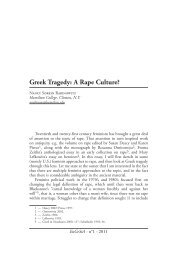Perspectives On and Of Livy's Tarpeia - EuGeStA
Perspectives On and Of Livy's Tarpeia - EuGeStA
Perspectives On and Of Livy's Tarpeia - EuGeStA
You also want an ePaper? Increase the reach of your titles
YUMPU automatically turns print PDFs into web optimized ePapers that Google loves.
192 TaRa WeLCh<br />
he follows her rather than the other way around) 57 . <strong>and</strong> like horatia,<br />
<strong>Tarpeia</strong> is explicitly a uirgo. This descriptor implies vestality, a “back-fill”<br />
detail to explain her presence in woman-poor Rome – especially after<br />
varro, who had connected the dots in the tradition 58 . Livy seems to<br />
exploit our assumptions about her (that as a virgin she is a vestal) even as<br />
he exploits her position as filia uirgo.<br />
The mixed perspectives <strong>Tarpeia</strong> generates by those who see her are<br />
intertwined with the notion of the Roman self <strong>and</strong> the invading (but<br />
to be incorporated) other. The two primary variants Livy names in his<br />
narrative – <strong>Tarpeia</strong> as Roman traitor (Pictor) or as Roman patriot (Piso)<br />
both locate <strong>Tarpeia</strong> between two peoples – Romans <strong>and</strong> sabine invaders<br />
– but interpret her loyalty <strong>and</strong> identity in opposite ways. In Pictor’s<br />
version her allegiance has shifted to the sabines (or at least, to herself <strong>and</strong><br />
her prize rather than to the Romans), <strong>and</strong> in Piso’s version she remains<br />
attached to her natal community. It is possible to interpret the women in<br />
the middle either way, for as a uirgo she is still connected to her father’s<br />
patria potestas but is eligible for moving horizontally. Unlike horatia, who<br />
calls out her fiancé’s name <strong>and</strong> thus makes public her allegiance, <strong>Tarpeia</strong><br />
is given no speech in Livy’s account to reveal which direction she faces<br />
as she is perched between perspectives: inside Rome looking out (Piso),<br />
or outside looking in (Pictor). It is telling here that in Piso’s version the<br />
sabines interpret her end game as fraude; a perspective which they do not<br />
share appears to them (fraude uisam agere) as deceitful. This is a classic<br />
“us vs. them” pose, only here the Romans are the fraudulent “them”.<br />
But this pose is h<strong>and</strong>ed down by Roman Piso. Livy’s brief mention of<br />
Piso’s variant cannily exposes the messiness of Roman growth. Like Piso’s<br />
version itself, which seeks to get inside <strong>Tarpeia</strong>’s mind, Livy’s mention of<br />
Piso’s variant places his reader in the mind of the other (here, Piso). again,<br />
history (<strong>Tarpeia</strong>, Romans, sabines) <strong>and</strong> historiography (Livy, Piso, Pictor)<br />
collide. Which viewpoint – Roman, Other, or Middle – do his readers<br />
inhabit? The plurality of perspectives Livy offers suggests that it must be<br />
all three. “Roman” is big enough to accommodate difference, <strong>and</strong> just as<br />
no one knows which of the horatii <strong>and</strong> Curiatii was Roman <strong>and</strong> which<br />
was alban, no one can decide if <strong>Tarpeia</strong> was one of us or one of them.<br />
The scornful tamen that opens the next story shows that to Livy, it doesn’t<br />
matter anyhow.<br />
The sabines’ motives for killing <strong>Tarpeia</strong> also confound self <strong>and</strong> other.<br />
accepti obrutam armis necauere, seu ut ui capta potius arx uideretur seu prodendi<br />
exempli causa, ne quid usquam fidum proditori esset (<strong>On</strong>ce they were<br />
57 — see hersch 2010: 140-4 on the importance of the deductio in domum mariti, the usual<br />
movement, as a symbol of Roman marriage.<br />
58 — De Lingua Latina 5.41, <strong>and</strong> cf. Martini 1998.



